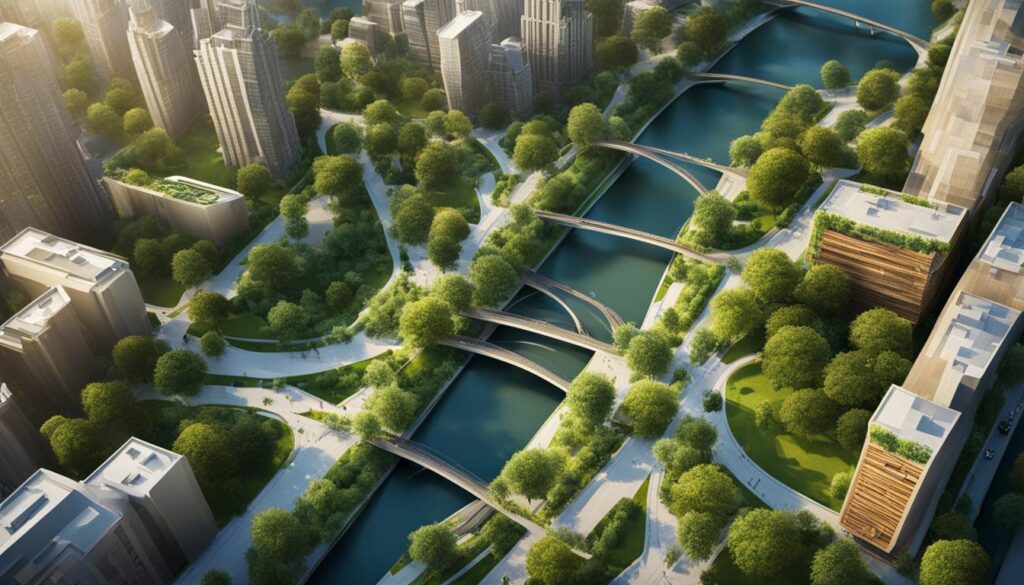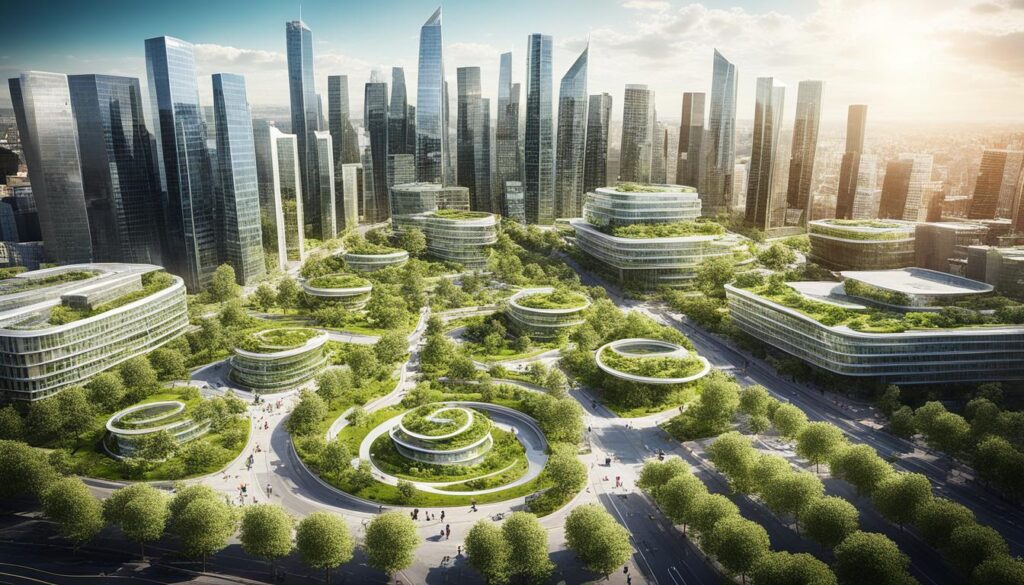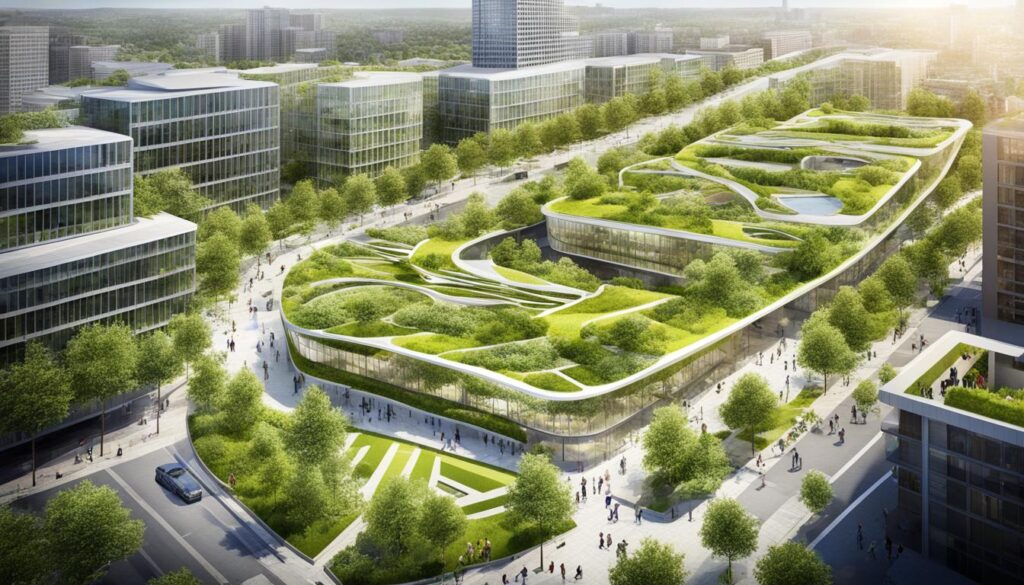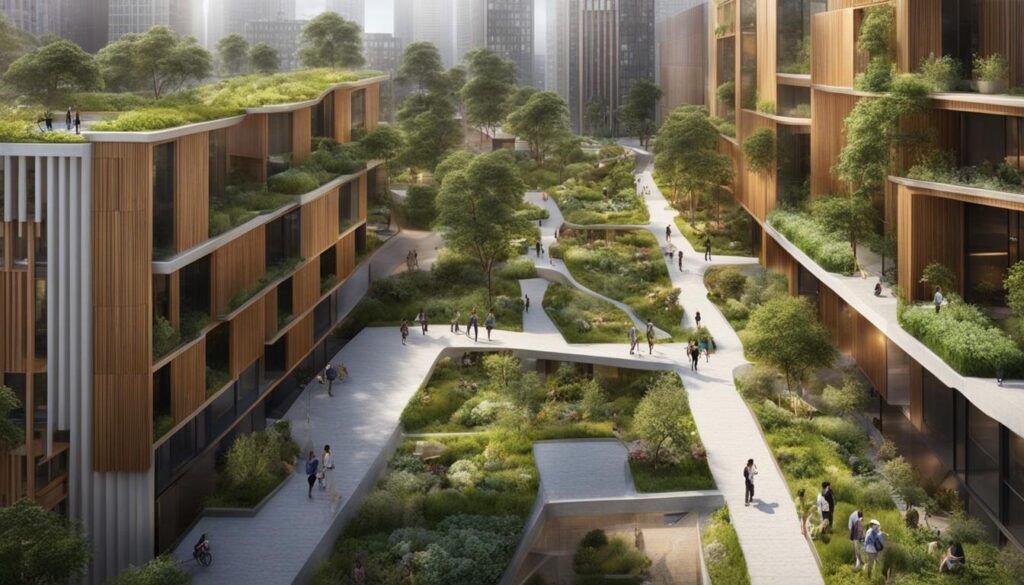When it comes to creating livable cities for future generations, fostering community resilience through sustainable urban planning is paramount. By combining the principles of sustainability and urban planning, we can build robust cities that thrive in the face of various challenges and uncertainties.
Sustainable urban planning plays a crucial role in achieving this goal. It encompasses a range of strategies and practices that aim to create resilient communities capable of effectively coping with and recovering from adversities such as natural disasters, economic downturns, and social disruptions.
By integrating sustainability into urban planning, we can promote the long-term well-being of our cities and their inhabitants. This holistic approach considers factors such as sustainable development practices, infrastructure design, and land-use planning, all of which contribute to building resilient communities.
Key Takeaways
- Sustainable urban planning is essential for creating resilient and thriving cities.
- It involves incorporating principles of sustainability into urban development practices.
- Community resilience can be achieved through inclusive decision-making and community engagement.
- Integrating resilience considerations into land-use planning and infrastructure design enhances urban resilience.
- Sustainable development practices contribute to the overall resilience of cities.
Understanding Community Resilience
Community resilience is a fundamental concept in urban planning that focuses on the ability of communities to withstand and recover from various challenges and stresses. It encompasses the capacity of individuals, families, and communities to adapt and thrive in the face of adversity.
When we talk about community resilience, we are referring to an integrated approach that takes into account the social, economic, and environmental dimensions of a community. It goes beyond merely bouncing back after a disaster; it involves proactive measures to build strong, adaptive, and sustainable communities.
Communities that possess high levels of resilience are better equipped to cope with and recover from disruptions, such as natural disasters, economic downturns, and social crises. They can minimize the impacts of these challenges and bounce back stronger and more resilient than before.
At the core of community resilience is the idea of fostering a supportive and interconnected community, where individuals and groups work together to address challenges collectively. This sense of community cohesion and collaboration forms a strong foundation for resilience. It enables communities to draw upon social networks, resources, and collective knowledge to navigate through difficult times.
Understanding community resilience is essential for urban planners as it provides a framework for identifying vulnerabilities, determining risks, and developing strategies to enhance the resilience of communities. By incorporating resilience principles into urban planning processes, we can create cities and communities that are better prepared to face the uncertainties of the future.
“Resilience is not just about surviving, but also about thriving and adapting to change.”
—Jane Jacobs
Urban planners play a crucial role in fostering community resilience by creating environments that support social connectivity, economic stability, and environmental sustainability. They consider various aspects, such as infrastructure design, land-use planning, and disaster preparedness, to ensure that communities are well-equipped to withstand and recover from shocks and stresses.
Key Features of Community Resilience
- Strong social networks and community cohesion
- Accessible and affordable healthcare and social services
- Diverse and inclusive economy
- Sustainable infrastructure and resource management
- Risk-informed land-use planning and regulations
- Effective disaster preparedness and response mechanisms
By emphasizing these key features, urban planners can contribute to building community resilience, ensuring the long-term well-being and sustainability of cities and communities.
| Benefits of Community Resilience | Challenges Addressed |
|---|---|
| Enhanced social cohesion and community well-being | Natural disasters |
| Improved economic stability and local economy | Economic downturns |
| Sustainable use of resources and environmental protection | Environmental degradation |
| Reduced vulnerability and enhanced preparedness | Social disruptions |
By strategically integrating community resilience principles into urban planning, we can create cities that are adaptable, sustainable, and better equipped to face the challenges of an uncertain future.
In the next section, we will delve deeper into the role of sustainable urban planning in enhancing community resilience. We will explore the strategies and practices that urban planners can employ to create resilient cities for future generations.
The Role of Sustainable Urban Planning
When it comes to building resilient communities, sustainable urban planning plays a pivotal role. By implementing effective urban planning strategies, cities can enhance their resilience to various challenges and create a more sustainable future. In this section, we delve into the key approaches and principles of sustainable urban planning that contribute to community resilience.
Promoting Urban Resilience
Sustainable urban planning incorporates resilience-building strategies that prioritize the well-being of communities and the environment. By integrating sustainable development practices, cities can foster urban resilience by minimizing vulnerabilities and enhancing adaptive capacities. These practices encompass efficient resource management, climate change mitigation, and the protection and restoration of natural ecosystems.
Strategic Infrastructure Design
Infrastructure design is a critical aspect of urban planning that influences a city’s resilience. Sustainable urban planning emphasizes the development of resilient infrastructure systems that can withstand and recover from disruptions. This involves incorporating measures such as advanced engineering techniques, smart technologies, and innovative transport systems to improve overall resilience and ensure reliable service delivery.
“Sustainable urban planning involves the integration of environmental, social, and economic considerations into the design and implementation of urban development projects.”
Land-Use Planning and Resilience
An integral part of sustainable urban planning is land-use planning. By strategically allocating land for different uses, cities can enhance their resilience. This includes designating areas for green spaces, parks, and urban forests, which contribute to climate regulation, biodiversity conservation, and community well-being. Additionally, zoning regulations that prioritize mixed-use development and compact urban form can enhance resilience by promoting walkability, reducing dependence on automobiles, and fostering community connectivity.
Enhancing Community Engagement
Successful sustainable urban planning relies on robust community engagement. By involving local residents, stakeholders, and community organizations in decision-making processes, cities can ensure that resilience-building strategies align with the unique needs and aspirations of the community. Community engagement fosters a sense of ownership and empowers individuals to actively participate in shaping their urban environment, resulting in more resilient and inclusive cities.
Through the implementation of sustainable urban planning strategies, cities can proactively address the challenges associated with urban growth and climate change. By integrating resilience-building practices into urban planning, communities can thrive in the face of uncertainty and create a sustainable future for generations to come.

Engaging the Community
In order to build resilient cities, it is essential to actively engage the community in the urban planning process. Community engagement fosters inclusivity, empowers residents, and ensures that the resilience framework is informed by the unique needs and perspectives of local individuals and groups.
One of the key aspects of community engagement is creating inclusive decision-making processes. By involving a diverse range of stakeholders, including residents, community organizations, and local businesses, urban planners can access a broader range of ideas and expertise. This collaborative approach helps build trust, foster dialogue, and enhance the overall resilience of the community.
Community participation is another crucial element of community engagement. Engaging residents in the decision-making processes and implementation of resilience initiatives not only strengthens their sense of ownership but also improves the effectiveness and sustainability of these initiatives. By involving residents in activities such as workshops, focus groups, and public consultations, urban planners can tap into their local knowledge and ensure that the resilience framework addresses their specific concerns and aspirations.
“Community engagement is a vital component of resilient urban planning. By actively involving residents and incorporating their perspectives, we can create cities that reflect the diverse needs and values of the community.”
To facilitate effective community engagement, it is crucial to develop a resilience framework that serves as a guiding document for urban planning initiatives. This framework should outline the objectives, strategies, and desired outcomes of resilience-building efforts and provide a roadmap for collaboration between urban planners, community representatives, and other key stakeholders.
The resilience framework should consider various dimensions of resilience, such as social, economic, and environmental aspects, to ensure a holistic approach to urban planning. By integrating community perspectives and knowledge into this framework, urban planners can prioritize the challenges and vulnerabilities that are most relevant to the local context, enabling targeted and effective resilience-building strategies.
Integrating Resilience in Urban Planning
Incorporating urban resilience planning into existing urban planning processes is crucial for building sustainable and resilient cities. By considering resilience factors in land-use zoning, infrastructure design, transportation planning, and other aspects of urban development, we can create cities that are better equipped to withstand future challenges.
Resilience, in the context of urban planning, refers to the ability of cities to bounce back and adapt in the face of shocks and stresses, such as natural disasters, climate change, and social disruptions. By strategically integrating resilience into urban planning, we can enhance our cities’ ability to withstand and recover from adverse events, ensuring the well-being and safety of our communities.
When it comes to land-use zoning, it is essential to prioritize areas with lower vulnerability to hazards and promote mixed-use developments that foster community resilience. By creating spaces that combine residential, commercial, and recreational areas, we enhance community connectivity and reduce dependence on single-use buildings, making our cities more adaptable and vibrant.
Infrastructure design also plays a critical role in urban resilience planning. By incorporating sustainability and resilience principles into the design and construction of infrastructure systems, such as water and energy networks, transportation systems, and green spaces, we can enhance their durability and adaptability to future challenges.
Transportation planning is another key area where resilience can be integrated. By promoting sustainable and multimodal transportation options, such as walking, cycling, and public transportation, we reduce our cities’ reliance on single-occupancy vehicles, decrease greenhouse gas emissions, and enhance our ability to adapt to disruptions in the transportation system.
In summary, integrating resilience in urban planning is essential for creating sustainable and resilient cities. By considering resilience factors in land-use zoning, infrastructure design, transportation planning, and other aspects of urban development, we can build cities that are better equipped to withstand and recover from challenges, ensuring the well-being and quality of life for future generations.

Sustainable Development and Resilience Benefits
In today’s world, it is more important than ever to prioritize sustainable development and resilience-building strategies in urban planning. By embracing sustainable practices and integrating them into our cities, we can create robust and resilient communities that can withstand and recover from various challenges and stresses.
Sustainable development encompasses a wide range of practices that promote environmental, social, and economic well-being. When applied to urban planning, these sustainable practices can have significant benefits for community resilience.
Benefits of Sustainable Development
- Environmental resilience: Emphasizing sustainable energy systems, green infrastructure, and sustainable building design helps reduce the negative impact on the environment. By preserving natural resources, minimizing pollution, and protecting ecosystems, we can create cities that are more resilient to climate change and other environmental challenges.
- Social resilience: Sustainable development also focuses on fostering inclusive and livable communities. By promoting affordable housing, accessible transportation, and quality public spaces, we can enhance social cohesion and improve the overall well-being of residents. This social resilience strengthens communities and enables them to adapt to social disruptions and economic changes.
- Economic resilience: Sustainable development practices can provide long-term economic benefits. Investing in renewable energy, energy-efficient infrastructure, and green technologies creates opportunities for job creation, economic growth, and reduced dependency on non-renewable resources. This economic resilience ensures cities can thrive in the face of economic challenges and uncertainties.
By prioritizing sustainable development in urban planning, we can build cities that are better equipped to handle future uncertainties, whether they be natural disasters, economic downturns, or social disruptions.
“Sustainable development is not a luxury; it is a necessity for building resilient and thriving cities.” – Jane Jacobs
Integrating Resilience and Sustainability
To effectively build resilience, it is crucial to integrate sustainable development practices into every aspect of urban planning.
| Urban Planning Strategy | Sustainable Development Integration |
|---|---|
| Land-use Planning | Implement zoning regulations that encourage mixed-use development, promote green spaces, and preserve natural areas. |
| Infrastructure Design | Incorporate energy-efficient systems, renewable energy sources, and climate-resilient design principles in infrastructure projects. |
| Transportation Planning | Prioritize sustainable and accessible transportation options, such as cycling, walking, and public transit, to reduce carbon emissions and promote active lifestyles. |
| Building Design | Encourage sustainable building practices, including energy-efficient design, use of recycled materials, and adoption of green building certifications. |
By integrating resilience and sustainability into these key areas of urban planning, we can create cities that not only support the well-being of their residents but also have the capacity to adapt, recover, and thrive in the face of future challenges.
Case Studies in Resilient Urban Planning
In this section, we will explore real-world case studies that exemplify the successful implementation of resilience-building strategies in urban planning. These case studies showcase cities and communities that have adopted innovative approaches to address resilience challenges and create sustainable urban environments.
Melbourne, Australia: Incorporating Nature-Based Solutions
Melbourne, known for its commitment to sustainable development, has embraced nature-based solutions as a key resilience-building strategy. The city’s urban planning strategies include the incorporation of green infrastructure, such as urban parks, green roofs, and vertical gardens. These nature-based solutions not only enhance the city’s aesthetics but also improve air quality, reduce urban heat island effects, and provide spaces for community engagement and recreation.

Copenhagen, Denmark: Cycling-Friendly Infrastructure
Copenhagen is renowned for its cycling-friendly urban planning strategies, which contribute to both resilience and sustainable development. The city has implemented an extensive network of cycling lanes, bike-sharing programs, and pedestrian-friendly zones. These initiatives not only reduce carbon emissions and traffic congestion but also enhance public health and well-being. By prioritizing active transportation, Copenhagen has created a resilient urban environment that is adaptable to future challenges.
New York City, USA: Climate-Resilient Infrastructure
New York City has been at the forefront of implementing climate-resilient infrastructure as part of its urban planning strategies. After the devastating impacts of Hurricane Sandy in 2012, the city recognized the need to enhance its resilience. Initiatives such as the construction of flood-resistant buildings, the establishment of waterfront parks, and the integration of innovative stormwater management systems have improved the city’s ability to withstand future climate events. These measures not only protect residents but also ensure the long-term sustainability of the city.
Singapore: A Vision of Sustainable and Resilient City
Singapore has become a global leader in sustainable urban planning, implementing a range of resilience-building strategies. The city-state has integrated sustainable development principles into its land-use planning, infrastructure design, and resource management. From the implementation of green building codes to the development of a comprehensive public transportation system, Singapore exemplifies the successful integration of resilience and sustainability into urban planning.
These case studies provide valuable insights into the diverse approaches to resilience-building in urban planning. By learning from the experiences of these cities and communities, we can develop transformative strategies that create resilient and sustainable urban environments for the future.
The Future of Resilient Urban Planning
In this section, we explore the future prospects of sustainable urban planning and its role in building urban resilience. As our cities continue to face numerous challenges, such as climate change, population growth, and socio-economic disparities, it is crucial that we adopt innovative strategies and approaches to ensure the long-term sustainability and resilience of our urban environments.
Emerging trends, technologies, and policies are reshaping the landscape of urban planning, offering new opportunities to address the complex challenges we face. One key trend is the increasing integration of technology and data analytics in urban planning processes. By harnessing the power of data, we can gain valuable insights into the functioning of our cities, enabling us to make informed decisions and design more efficient and resilient urban systems.
Another important aspect of the future of resilient urban planning is the emphasis on inclusive and community-centered approaches. Recognizing that community engagement is vital for effective urban planning, future strategies will prioritize participatory decision-making processes that involve residents, businesses, and other stakeholders. This collaborative approach ensures that the diverse needs and aspirations of the community are considered, leading to more inclusive and resilient urban environments.
Image: Representing the harmonious integration of sustainable urban planning practices.
The integration of sustainability principles into urban planning is a key component of future resilience-building strategies. By prioritizing sustainable development, incorporating green infrastructure, and promoting energy-efficient strategies, we can create cities that are more environmentally friendly, socially inclusive, and economically robust.
In addition to these trends, future urban planning will require continuous adaptation and innovation. As we face evolving challenges and uncertainties, our approach to urban planning must be flexible and responsive. This means embracing new ideas, experimenting with different solutions, and continuously learning from both successes and failures.
As we look ahead, the future of resilient urban planning holds great promise. By embracing emerging trends, integrating sustainable practices, engaging the community, and fostering innovation, we can build cities that are not only resilient but also sustainable, livable, and vibrant.
Conclusion
In conclusion, sustainable urban planning plays a vital role in fostering community resilience through sustainable urban planning, creating robust cities for future generations. By integrating resilience-building strategies, engaging the community, and prioritizing sustainable development, we can build cities that are better prepared to face the challenges of the future.
Through sustainable urban planning, we can create cities that are not only environmentally friendly but also socially and economically resilient. By implementing sustainable practices such as green infrastructure, renewable energy systems, and sustainable building design, we can enhance the overall resilience of our cities.
Furthermore, community engagement is crucial in resilient urban planning. By involving local residents in decision-making processes, we can ensure that their unique needs and perspectives are considered. This inclusive approach promotes a sense of ownership and encourages the community to actively participate in building resilience.
By prioritizing sustainable development and adopting resilience-building strategies, we can create cities that are not only capable of withstanding natural disasters and other challenges but also provide a high quality of life for their residents. Through sustainable urban planning, we can foster community resilience and create a better future for all.
FAQ
What is community resilience?
Community resilience refers to the ability of a community to effectively respond to and recover from various challenges and stresses. This includes natural disasters, economic downturns, social disruptions, and other shocks and stresses that may impact the community.
How does sustainable urban planning contribute to community resilience?
Sustainable urban planning plays a crucial role in building community resilience by incorporating strategies and principles that promote long-term sustainability and adaptability. This includes sustainable development practices, resilient infrastructure design, and proactive land-use planning to mitigate risks and enhance the community’s ability to bounce back from adverse events.
Why is community engagement important in resilient urban planning?
Community engagement is essential in resilient urban planning as it ensures that the unique needs and perspectives of local residents are considered. Inclusive decision-making processes, active community participation, and the development of a resilience framework that reflects the community’s values and aspirations are key to fostering community ownership and enhancing the effectiveness of resilience-building efforts.
How can urban resilience planning be integrated into existing urban planning processes?
Urban resilience planning can be integrated into existing urban planning processes by incorporating resilience considerations into various aspects of urban development. This includes land-use zoning that minimizes vulnerability to hazards, infrastructure design that incorporates resilience features, and transportation planning that prioritizes accessibility and connectivity even during crises.
What are some examples of sustainable development practices that contribute to community resilience?
Sustainable development practices, such as the use of sustainable energy systems, implementation of green infrastructure, and adoption of sustainable building design, contribute to community resilience by promoting resource efficiency, reducing environmental impacts, and enhancing the overall sustainability of cities. These practices help create cities that are better prepared to withstand and recover from shocks and stresses.
Are there any real-world examples of successful resilient urban planning?
Yes, there are several real-world case studies that showcase successful implementation of resilience-building strategies in urban planning. For example, cities like Copenhagen, Denmark, have implemented policies to address climate change impacts and promote sustainable transportation, while cities like Medellín, Colombia, have transformed informal settlements into vibrant and resilient communities through innovative urban planning approaches.
What does the future hold for resilient urban planning?
The future of resilient urban planning involves embracing emerging trends, technologies, and policies that further enhance community resilience and sustainability. This includes the integration of smart city concepts, harnessing the power of data and analytics, and continuously adapting and innovating urban planning practices to address the evolving challenges and opportunities of the future.
